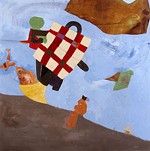‘Life Still’
In the exhibit 'Life Still,' Stella Alesi, Gabel Karsten, and Mo Scollan aren't just showing still lifes of bathroom sinks and kitchen objects, but portraiture breaking away from tradition
Reviewed by Benné Rockett, Fri., April 21, 2006

Life Still
2040 Gallery, through May 27
If one were to view the current exhibition at 2040 Gallery without attending to the statements prepared by artists Stella Alesi, Gabel Karsten, and Mo Scollan, one would likely perceive the works as abstracted organic forms (sometimes framing individuals) and still lifes of bathroom sinks and kitchen objects. What you are actually viewing is portraiture breaking away from tradition. The most basic definition of a portrait is a visual representation that serves as a likeness of an individual.
The grouping of objects and inclusion of animates are contextual clues concerned with the internal and external life of the sitter. The object-centric presentation in "Life Still" offers an opportunity for biographical information to intermingle with the autobiographical. As Alesi points out, "Everything is interconnected."
Alesi presents abstracted organic forms, straightforward portraits, and a combination of both to make this point clear. The quick release of self in the organic flatworks, combined with portrait elements, take on a universal tone.
Scollan documents the objects and animates she must engage with to nurture herself and her family. Common kitchen objects project a luminosity that suggests holiness while the momentary mug shot of a cardinal signals a need to center oneself.
Karsten allows for the highly object-centric format of portraiture in these paintings of sinks. As with Scollan's, the sinks glow from within, but it is the objects surrounds that begin to describe the identities of the owners. The specific mood or the objects' capacity to project mood is what makes the sinks function as portraiture.
The artists in "Life Still" present unconventional formats for a traditional genre.










